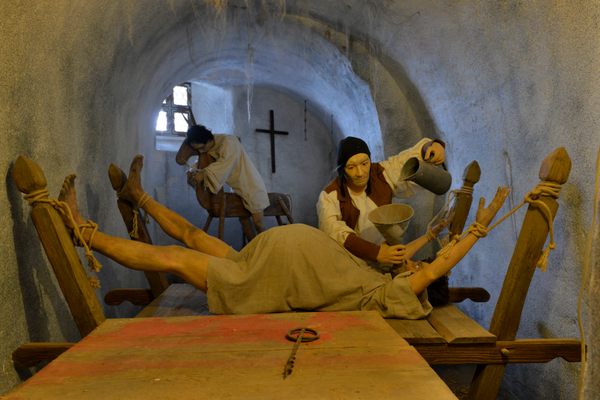Kriminalmuseum: Germany’s Terrifying Museum of Medieval Torture
 Das Streckbett (stretching ladder) (all photographs courtesy of the Kriminalmuseum des Mittelalters, sourced by Leipzig Tourismus)
Das Streckbett (stretching ladder) (all photographs courtesy of the Kriminalmuseum des Mittelalters, sourced by Leipzig Tourismus)
If you were on a currywurst crawl through the backstreets of central Leipzig, Germany, you might never expect to find a rather grim museum up a dank, narrow staircase flanked by fast-food vendors, just around the corner from the birthplace of the composer Richard Wagner. I thought sitting through an entire Wagner opera was torture enough before I set eyes on some of the gruesome instruments housed at the Medieval Crime Museum (the Kriminalmuseum) on Nikolaistrasse.
Displayed in Leipzig since 2010, most of this astonishing private collection was sourced from Bohemia and dates back as far as the 1300s; though some wooden implements have been repaired or reconstructed, all metal parts are original. Visitors will hardly notice the creaking floorboards and rather kitsch wall-to-wall red crushed velvet with their eyes locked on these contraptions designed to inflict unimaginable pain, maim, and kill.
Staff were initially upset that I wanted to take photos, explaining they didn’t want pictures to be taken out of context since the museum’s stance is staunchly anti-violence. They relaxed as soon as I assured them I didn’t think they actually liked torture, and were even happy for me to touch some of the wooden components, inviting me to pull down on a lever to gage the weight of the bade attached. (I could barely make it budge.)

 Hexenstuhl (witch-chair or interrogation chair, from a 17th-century original)
Hexenstuhl (witch-chair or interrogation chair, from a 17th-century original)
It’s not a particularly anglophone-friendly museum, but you don’t need to read a plaque to feel squeamish about the foreboding machinery on show. Most items are accompanied by illustrations, woodcarvings, and prints from the era to show how bodies fit around and into various nooks, crannies, and spiky bits; it’s not always self-explanatory. Details about the crimes that warranted the use of these contraptions are fascinating: the simple saw, it turns out, was a popular punishment for homosexuals.
There’s a sort of beginner’s torture kit with all the basics: the obligatory French guillotine, stocks for public humiliation (also known as a “shrew’s fiddle”) in which the constrained prisoners would endure the contents of chamber pots being smeared in their ears, and a stretching rack that dislocates the victims’ shoulders as a prelude to the actual torture. As a non-German speaker, I reveled in the names for each device, which for all I’d know could have otherwise been Krautrock bands or types of marzipan: das Streckbett for the rack, or Hexenstuhl for the “witch” chair widely used for interrogations, studded with iron points that could be heated by fire for that little bit of extra discomfort.
 The Scavenger’s Daughter
The Scavenger’s Daughter
My personal favorite looks like something that would go down well at an S&M party. Known enigmatically as the “stork” or “scavenger’s daughter,” in use circa 1500-1650, this binding apparatus would cause muscle convulsions for hours or days on end. Try getting out of that, Copperfield.
 Yep, that’s the Breast Claw
Yep, that’s the Breast Claw
One I’d least like to be used on me — though I’m not putting my hand up for anything else — is the “breast claw” (Brusthralle), 1300-1700. The pincers, cold or red hot, would be manipulated to mangle the breasts of unmarried mothers as well as women accused of heresy, white magic, abortion, and other female misdeeds.
So how does this place sustain itself in a small East German city like Leipzig? It is a town with a rich medieval history; Goethe’s Faust was partly inspired by the author’s favorite drinking den here (the 15th-century Auerbach’s Keller), and Leipzig now boasts a thriving punk scene as well as the largest gothic festival in the world, the annual Wave-Gotik-Treffen.
The Kriminalmuseum collection does look a little like a goth’s wishful Ikea catalogue: everything is rusted, rigid, unwieldy — certainly worse than anything I’ve seen in Game of Thrones. It was all used in real life, day-to-day, in small villages all over Europe. And as the museum’s curator is keen to point out, ancient and barbaric as these apparatuses are, torture is still very much in practice around the world.








Follow us on Twitter to get the latest on the world's hidden wonders.
Like us on Facebook to get the latest on the world's hidden wonders.
Follow us on Twitter Like us on Facebook